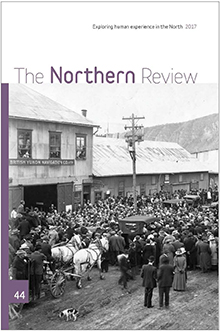Alaska’s Economy: The First World War, Frontier Fragility, and Jack London
Keywords:
Jack London, Alaska Economy, Staples, Support Sector, Polk Directory, Economic ResilienceAbstract
The Northern Review 44 (2017): 327–346
The two world wars had dramatically different effects on the Alaska economy. The military build-up during the Second World War created an economic boom and laid the foundation for the modern Alaska economy. The First World War contributed to an economic decline that followed the dramatic expansion of mining activity and population in the first decade of the century. The boom and bust story is familiar to anyone interested in the economies of frontier regions. The frontier is assumed to be a fragile economy dependent on the economic fortunes of its resource industries. The economy expands and contracts with staples production. The support sector plays a passive role in economic growth and development of the frontier. Jack London suggested a different role for firms in the frontier’s support sector. He hypothesized that in a staples bust some portion of this support sector would remain. This remainder would change the frontier economic environment, providing services and reducing costs for the future. The supporting industries become an active participant in a virtuous cycle of economic development on the frontier. The First World War provides a natural experiment to test Jack London’s hypothesis. This paper looks at the effects of the decline in Alaska’s staples industries, which started in the First World War, on the territory’s support sector. Did the supporting industries simply collapse like gold, copper, and fishing? Or did these industries seem resilient in the face of the staples decline? Census and Polk Directory data are used to test this hypothesis. This article is part of a special collection of papers originally presented at a conference on “The North and the First World War,” held May 2016 in Whitehorse, Yukon.
Downloads
Published
Issue
Section
License
Authors who publish with this journal agree to the following terms:
a. Authors retain copyright and grant the journal right of first publication, with the work simultaneously licensed under a Creative Commons License that allows others to share the work with an acknowledgement of the work's authorship and initial publication in this journal.
b. Authors are able to enter into separate, additional contractual arrangements for the non-exclusive distribution of the journal's published version of the work (e.g., post it to an institutional repository or publish it in a book), with an acknowledgement of its initial publication in this journal.
c. The journal has the right to authorize third-party publishers & aggregators to include the Article in databases or other services (EBSCO, Proquest).
d. The journal has the right to share the Article on the Internet, through social media and other means.


